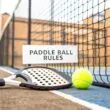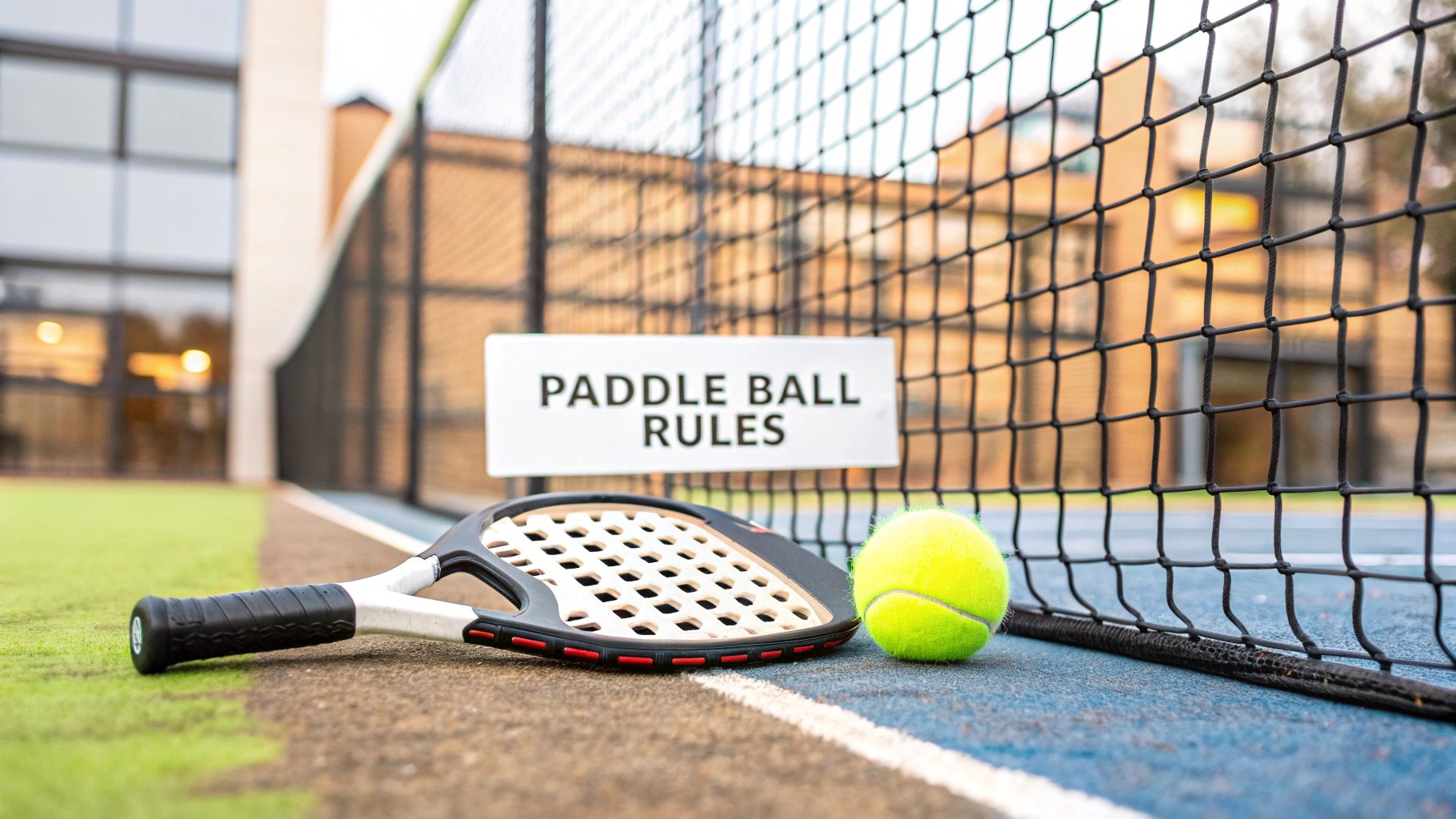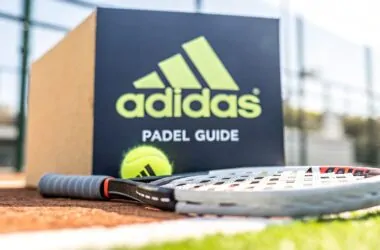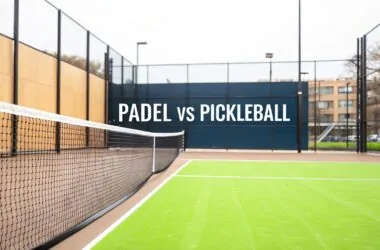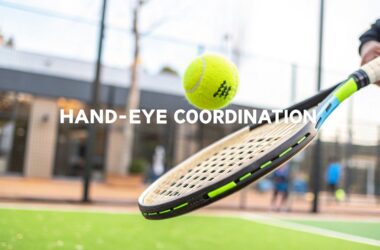The essentials of paddle ball game rules boil down to this: it's a doubles game, you serve underhand, the scoring is just like tennis (15, 30, 40), and those glass walls around you? They're totally in play. Just think of it as a mashup of tennis and squash, built for lightning-fast rallies and a whole lot of strategy.
Decoding the Basics of Padel
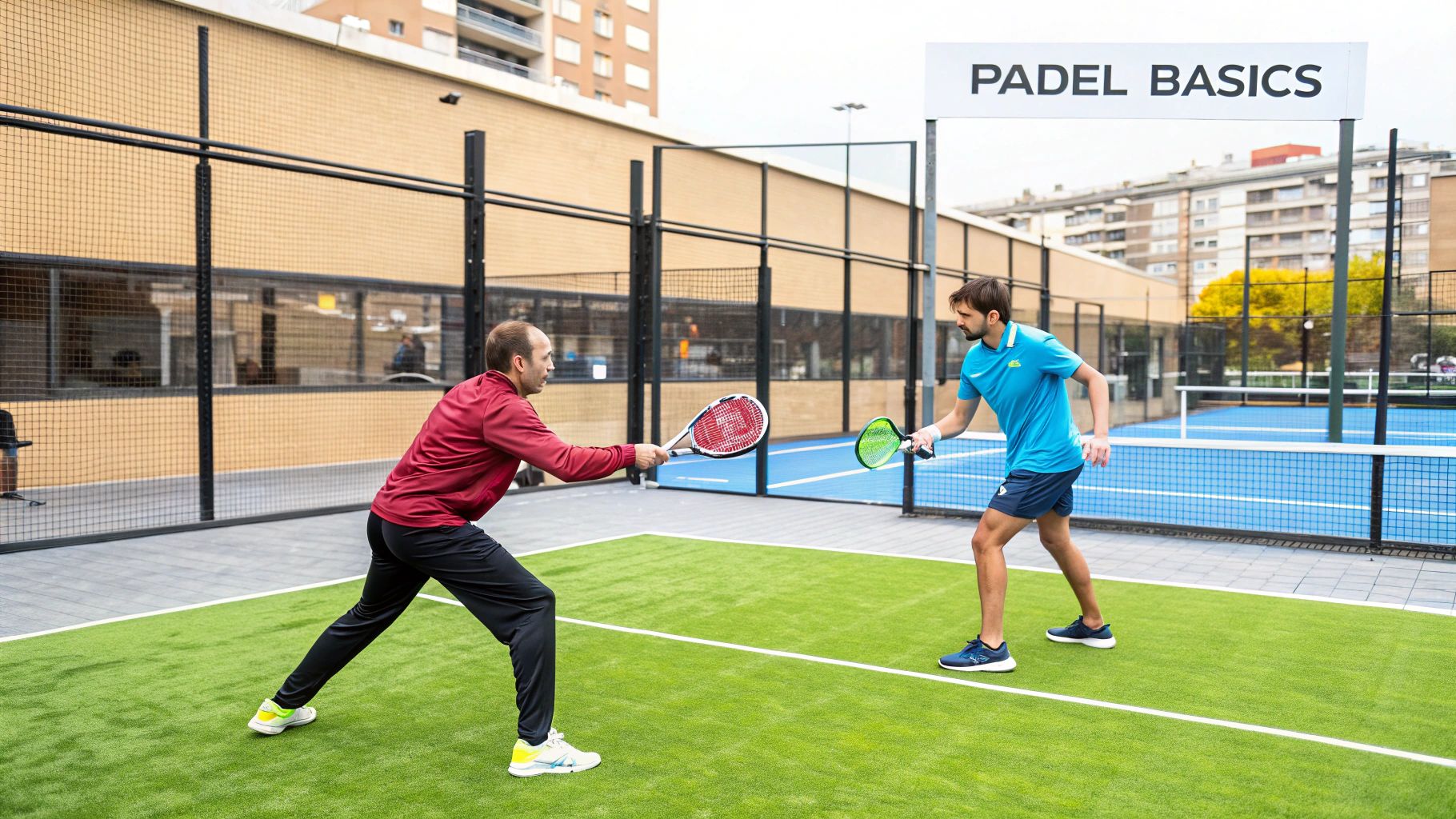
Welcome to your definitive guide to padel, the addictive sport that's taking the world by storm. This is your starting point, designed to get you up to speed on the core principles before we dive into the nitty-gritty. There's a reason padel is exploding in popularity—it’s incredibly easy to pick up, but has enough strategic depth to keep you hooked for life.
The game's fundamental rules haven't changed much since 1969, when Mexican businessman Enrique Corcuera first came up with the idea. He built the very first court at his home, setting the standard 20 by 10-meter dimensions and enclosing it with walls, which is what defines the game today. You can always explore more about the sport's origins and its incredible journey to global fame.

Buy the best padel gear to level up your next game!
CHECK OUT this deal from Padel Market!Get ready to take your game to the next level with the latest padel gear from Padel Market! Fast EU and Worldwide Shipping
To get you started on the right foot, the easiest way to grasp padel is to see how it stacks up against its famous cousin, tennis. They might share a scoring system, but the actual feel of the game is worlds apart, all thanks to a few crucial rule changes.
Padel vs Tennis Key Rule Differences
For anyone with a tennis background, getting a handle on these differences is the fastest way to feel comfortable on a padel court. The smaller court, underhand serve, and the ability to play off the walls completely transform the game's dynamics.
This table gives you a quick snapshot of where the two sports diverge:
| Feature | Paddle Ball (Padel) Rules | Tennis Rules |
|---|---|---|
| Court Type | Smaller (20m x 10m), enclosed by glass and mesh walls. | Larger (23.77m x 10.97m), open court with no walls. |
| Serve Style | Must be underhand, with the ball bounced once before contact. | Can be overhand or underhand, with no bounce required. |
| Rally Dynamics | Walls are in play; the ball can be hit after rebounding off them. | Walls are out of bounds; the rally ends if the ball hits anything. |
| Equipment | Solid, stringless paddle with perforations; lower pressure ball. | Strung racket; higher pressure, bouncier ball. |
| Primary Format | Almost exclusively played in doubles format (two vs. two). | Played in both singles (one vs. one) and doubles formats. |
Key Takeaway: If you remember one thing, make it this: the walls are not boundaries; they are your best friends. Learning how to use them to your advantage is the first real step toward mastering padel.
Once you internalize these core differences, you’re well on your way to understanding the unique flow and strategy of a padel match. This foundation is exactly what you need as we move on to the more detailed mechanics, ensuring you step onto the court with the confidence of someone who's been there before.
Understanding the Court and Equipment
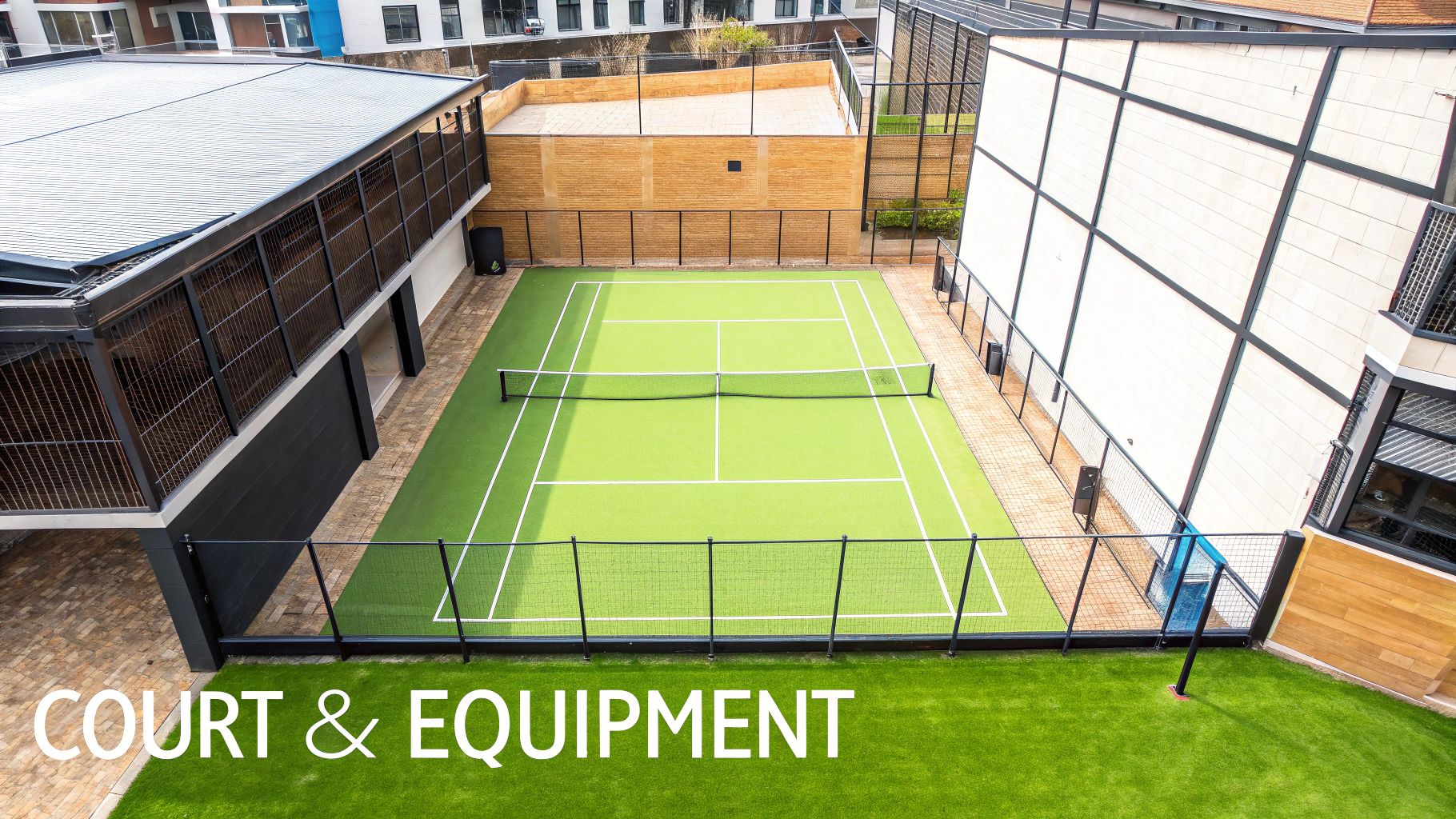
Before you can get into the finer points of strategy, you first have to get a feel for your surroundings. The padel court is more than just a place to play; it’s an active part of every single rally. Getting to know the court and your gear is the first real step to mastering the game.
Picture a rectangular box, 20 meters long and 10 meters wide, completely walled in. It’s smaller and more intimate than a tennis court, which naturally speeds things up and puts a premium on quick teamwork. But it’s those walls that really change everything, turning a flat game into a three-dimensional chess match.
Decoding the Court Layout
The layout is simple on the surface but has a ton of strategic depth. A net splits the court down the middle, just like tennis. On each side, a service line is drawn 6.95 meters back from the net. Another line runs down the center from the net to the service line, creating the two service boxes you'll be aiming for.
But let's talk about the main event: the walls. The back walls are solid glass, usually up to 3 meters high, while the side walls are a mix of glass and wire mesh. This isn't just for show; it’s fundamental to how padel is played.
- Glass Walls: These give you a clean, reliable bounce. You can let the ball hit the back or side glass after it bounces once on the court and play it on the rebound. This is a core part of padel strategy.
- Mesh Fencing: The mesh is the wildcard. Balls coming off the fence tend to die or skid unpredictably, making them much trickier to return.
The biggest mistake new players make is treating the walls like they're "out." The court isn't just a boundary; it's a tool. Learning to use the glass to reset a point or hit a crazy angle is when you really start to get padel.
This enclosed design keeps the ball in play much longer. Shots that would be long in tennis are fair game here, forcing you to stay aware of everything happening around you—not just what's coming over the net, but what might be coming off the back wall.
The Tools of the Trade
Just like the court, the equipment is totally unique to padel. You won’t see any stringed rackets on a padel court. Instead, players use a solid, perforated paddle, often made from foam, carbon fiber, or fiberglass.
The paddle has no strings, just a solid face dotted with holes. Those holes aren't just for looks; they cut down on air resistance so you can swing faster, and they make the paddle lighter. A padel paddle is built for feel and control, not the raw power of a tennis racket. Its solid surface gives you great feedback, making it easier to hit those soft drop shots and controlled volleys that win points.
The ball is the final piece of the puzzle. It looks a lot like a tennis ball, but it has less internal pressure. This means it doesn't bounce as high, which slows the game down just enough to encourage longer, more tactical rallies. It’s this combination—a control-focused paddle and a lower-bouncing ball—that makes padel a game of strategy and placement over brute force.
If you want to go deeper on the gear, this complete guide to padel tennis equipment is a great place to start.

Buy the best padel gear to level up your next game!
CHECK OUT this deal from Padel Market!Get ready to take your game to the next level with the latest padel gear from Padel Market! Fast EU and Worldwide Shipping
How to Serve and Start Every Point
Every single point in padel kicks off with a serve. But if you’re coming over from tennis, you need to hit the reset button on your expectations. The padel serve isn't about raw power or blasting aces past your opponent.
Think of it more like a strategic opening move. It’s closer to a bowler carefully placing their first ball than a tennis player launching a missile. Understanding the specific paddle ball game rules for the serve is your first real step toward controlling the match's tempo. The goal here is to start the rally on your terms, immediately putting the other team in an awkward spot. It’s all about placement and consistency with a simple underhand motion.
The Three Pillars of a Legal Serve
To pull off a legal serve in padel, you have to follow three core rules without exception. Mess up any of these, and you’ve got a fault on your hands. Think of them as the non-negotiable foundation of every point you play.
This infographic breaks it down perfectly, showing the three key things you have to get right for a legal serve.
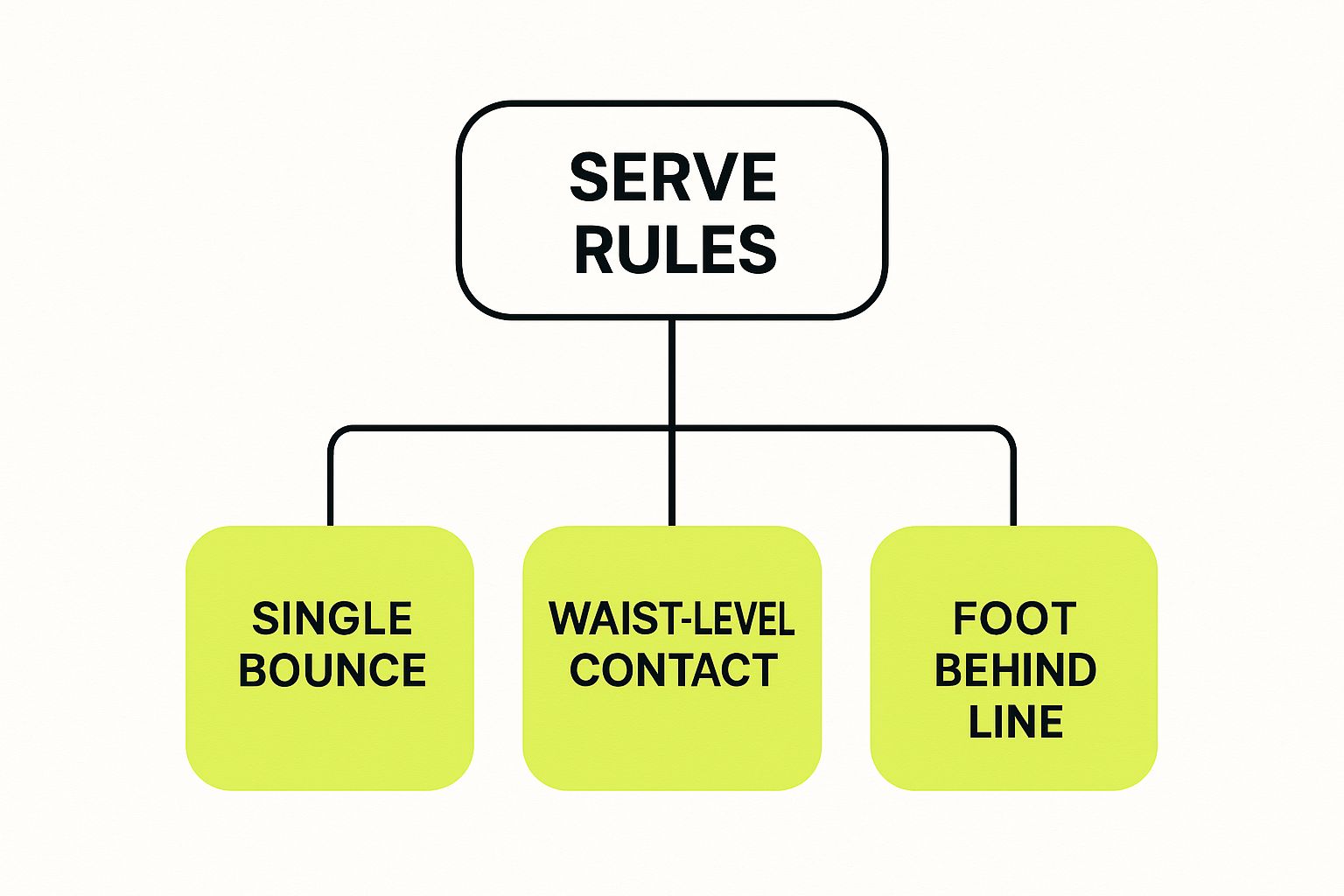
As you can see, a legal serve is an equal mix of getting the bounce right, making contact at the correct height, and keeping your feet planted.
1. Let the Ball Bounce Once
First thing's first: you must drop the ball and let it bounce once on the ground behind the service line before you hit it. You can't hit it straight out of your hand or toss it up in the air like in tennis. This mandatory bounce is what makes the padel serve what it is—an underhand shot.
2. Make Contact At or Below the Waist
The second rule is all about your point of contact. You have to strike the ball at or below your waist level. This is a crucial rule that prevents players from generating crazy topspin or power, keeping the serve as a way to start a rally, not end it. A good tip is to imagine a line drawn straight from your belly button; your paddle can’t connect with the ball above that line.
3. Keep One Foot on the Ground
Finally, as you swing and hit the ball, at least one of your feet must stay on the ground. No jumping or running into your serve. On top of that, both of your feet need to be behind the service line and on the correct side of the center line. This rule ensures you’re stable and further limits your ability to generate overwhelming speed, reinforcing the game’s strategic nature.
Key Takeaway: The serve is a controlled, underhand motion. You drop the ball, let it bounce once, and hit it at or below your waist while keeping one foot on the ground behind the line. It's a simple sequence that puts precision way ahead of aggression.
Targeting and Faults
Okay, so you've got the motion down. Now where do you aim? The serve has to travel diagonally across the net and land in the opponent's service box. If it lands cleanly in the right box, the point is live.
Of course, a few things can go wrong:
- Out Fault: If your serve misses the service box completely—landing long, wide, or even in the wrong box—it’s a fault.
- Net Fault: If the serve clips the net and then lands outside the correct service box, that's also a fault.
- Foot Fault: If you step on or go over the service line with either foot before you make contact with the ball, that’s a foot fault.
You get two attempts to hit a legal serve. If you fault on your first try, you get a second chance. Fault on the second serve, and that’s a double fault—you lose the point.
Understanding the Let Serve
There’s one important exception here, and it’s called a "let." A let happens when your serve hits the top of the net but then lands legally inside the opponent’s service box. When this happens, the serve just doesn't count, and you get to replay that serve.
It's not a fault; it's simply a do-over to make sure the point starts fairly. For a much deeper dive, you can learn more about the finer points of the padel serve rules and see how the pros handle these situations in a match.
The Art of Scoring and Winning the Match
If you've ever watched a tennis match, you're already halfway to understanding how to score in padel. The system is nearly identical, and getting a handle on it is your key to unlocking the game’s rhythm and strategy.
It’s a simple ladder: you win points to win a game, win games to win a set, and win sets to win the match. This structure is a core part of the paddle ball game rules, and it dictates the entire flow of play. Once it clicks, you’ll know exactly when to push for a point and what’s on the line with every single rally.
The Climb from Zero to Game
Think of winning one game as climbing a small, four-step ladder. Both teams start at zero, which in the world of racquet sports is called "Love." From there, every point you score moves you up a step.
Here’s how a single game breaks down:
- 1st point won: Score is 15
- 2nd point won: Score is 30
- 3rd point won: Score is 40
- 4th point won: Game
But there’s a catch. To win the game on that fourth point, you have to be at least two points ahead of your opponent. This "win by two" rule is where the real drama happens.
If the score gets tied at 40-40, we call this "Deuce." To win from Deuce, a team has to score two points in a row. Winning the first point gives you the "Advantage." If you win the next point, you take the game. But if you lose it, the score snaps right back to Deuce, and the battle continues until one team finally gets that two-point lead.
From Games to Sets
Once you’re comfortable winning games, the next goal is to string them together to win a set. A set is basically a race to six games.
But that same "win by two" rule applies here, too. You can win a set 6-4 or 6-3, but you can't win it 6-5. If the score hits 6-5, the leading team has to win the next game to close out the set 7-5. If the trailing team wins that game, the score becomes 6-6, and it’s time for a tie-break.
The High-Stakes Tie-Break
When a set is locked at 6-6, a 7-point tie-break decides the winner. This is a fast-paced, high-pressure showdown where every point feels massive. The scoring switches from the classic "15, 30, 40" system to simple counting: 1, 2, 3, and so on.
The first team to score seven points wins the tie-break, as long as they are ahead by at least two. So, a 7-5 score wins it, but if it gets to 6-6, play continues until one team pulls ahead by two (like 8-6 or 9-7).
The serving rotation is a little different here. The player who was supposed to serve the next game starts the tie-break, serving just one point from the right side. After that, the serve flips to the other team for two points, starting from their left side. This two-point serving rotation continues until a winner is decided.
A full padel match is typically the best of three sets. The first team to win two sets takes home the victory.
To give you a clearer picture, let's break down how it all fits together.
Anatomy of a Padel Match
This table shows how the smallest unit—the point—builds up to an entire match victory.
| Unit | How to Win It | Key Rules |
|---|---|---|
| Point | Hit a winning shot or force an opponent error. | The ball can only bounce once on your side. |
| Game | Be the first to win 4 points. | Must win by a 2-point margin. (e.g., 40-15) |
| Set | Be the first to win 6 games. | Must win by a 2-game margin. (e.g., 6-4) |
| Tie-Break | Be the first to 7 points if a set is tied 6-6. | Must win by a 2-point margin. (e.g., 7-5) |
| Match | Be the first team to win 2 sets. | In a best-of-three format. |
This structure is what makes padel so exciting. The momentum can shift in an instant, and understanding this scoring system lets you follow along with every twist and turn.
For an even deeper dive into the specifics, you can explore the official rules of padel to see how these concepts are applied in competitive play.
Common Faults and How to Avoid Them
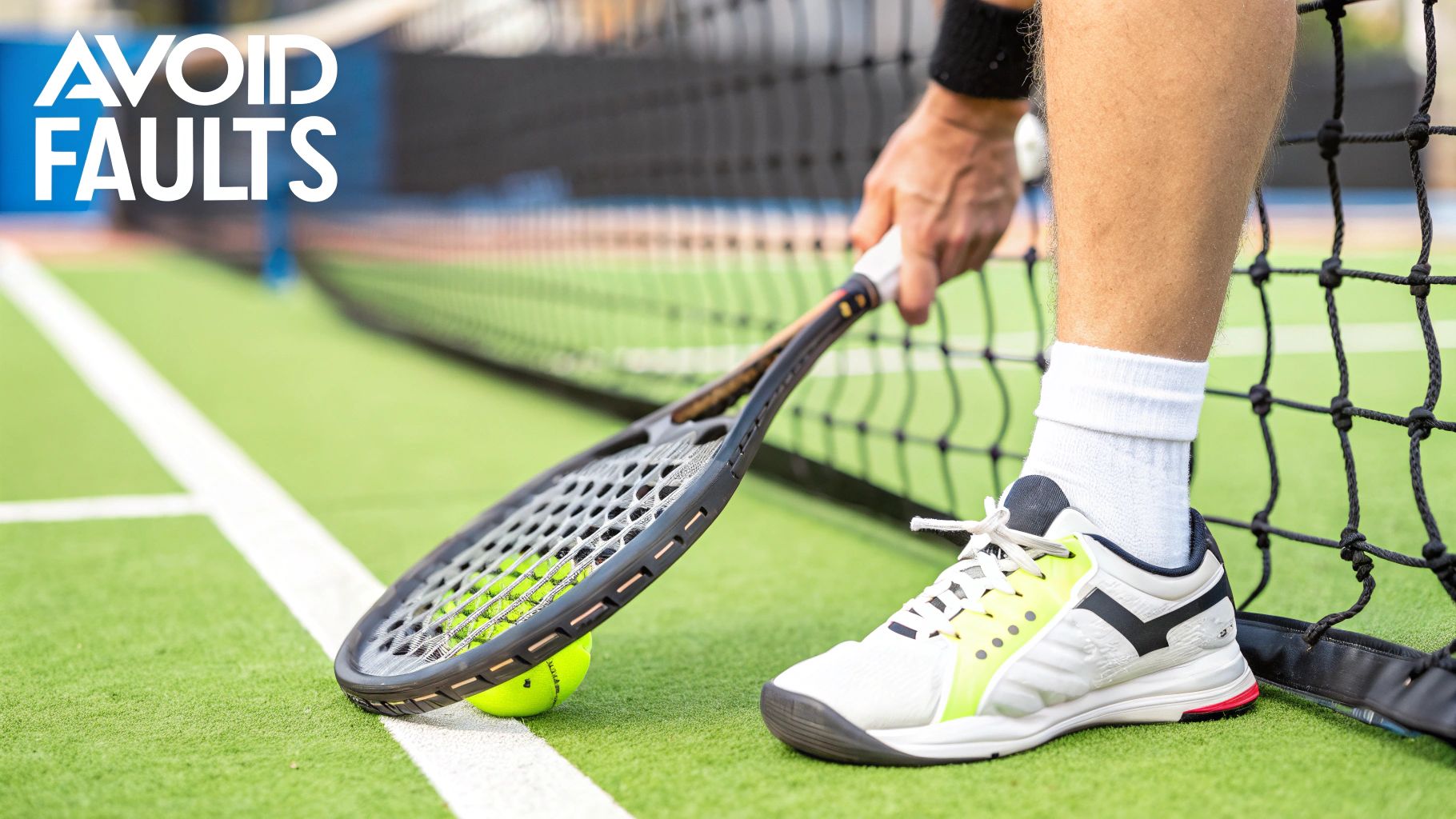
Knowing the paddle ball game rules isn't just about what you can do—it's also about what you can't. A fault is any move that breaks the rules, and it costs you the point. Simple as that. New players get the hang of obvious mistakes pretty quickly, like letting the ball bounce twice or smacking it into the net. But padel has its own unique set of faults that can easily trip you up.
Mastering these specific rules is what separates a casual player from a smart, competitive one. When you cut down on unforced errors, you make your opponents earn every single point. That pressure shifts right over to their side of the net.
Let's dig into the most common padel-specific faults and how to stay out of trouble.
Wall and Fence Infractions
The walls are your best friend in padel, but they have a strict set of rules. Getting them wrong is one of the fastest ways to hand points to the other team. Here's the golden rule: the ball must hit the ground on your opponent's side before it touches their back wall or fence.
Let’s break down what’s legal and what’s not:
- Direct Fence Hit (Fault): You hit the ball, and it flies straight into the wire fence on the other side without bouncing first. That’s your point lost. The fence is out of bounds for a direct hit.
- Direct Wall Hit (Fault): Same deal for the glass walls. If your shot hits your opponent's back or side wall before it bounces on the court, it's a fault.
- Legal Wall Rebound (In Play): This is what you want. The ball flies over the net, lands in your opponent's court, bounces once, and then plays off their glass walls. The ball is still very much live, and they have to return it.
Key Takeaway: Always think ground-first. The floor on your opponent's side is the ball's first destination after you hit it. The walls are for the rebound, not the initial target.
Illegal Volleys and Net Play
Volleying is a massive part of padel strategy, but it comes with one non-negotiable restriction: you cannot volley the return of serve. When your opponent serves, you absolutely must let the ball bounce on your side before hitting it. Taking it out of the air is an instant fault. No exceptions.
On top of that, watch out for the net. If you touch the net with your paddle, your body, or even your clothes during a point, you lose the point. This is super easy to do when you're in a fast-paced rally up close. Keep your balance and stay aware of your spacing to avoid giving away a point on a silly mistake.
Serve-Specific Faults to Watch
The serve has a few tricky rules that can catch even experienced players off guard. The most common slip-up is the foot fault. This happens when any part of your foot touches or steps over the service line while you're hitting the serve. You have to stay behind that line until you make contact with the ball.
Another big one is player contact. In countries where the sport is huge, like Spain and Argentina, tournaments follow the International Padel Federation rules to the letter. A key rule states that if the serve hits the receiving player (or their partner) before it bounces, the server wins the point. This just goes to show why the receiving team needs to be on their toes. You can learn more about the global standards that have shaped the history of padel and its rules over time.
Finally, remember this simple rule: if the ball hits you or your partner's body at any time—even if you're standing outside the court—you lose the point. Your paddle is the only legal tool you have. Steer clear of these common faults, and you’ll instantly become a more solid, reliable player.
The Evolution of Padel’s Rules
To really get a handle on the modern paddle ball game rules, you have to look at where the sport came from. Padel wasn't some happy accident; its DNA is a clever mix of other racquet sports, all put together to create a game that's more social, easier to get into, and full of strategy. The rules we play by today are the result of smart changes all aimed at one thing: making it as fun as possible.
The story starts way before padel became the global hit it is today. You can see its roots in older games that tried to shrink tennis down to a more manageable size. These paddle sports started popping up in the late 19th and early 20th centuries. A big one was paddle tennis, created around 1898 by an American coach named Frank Beal. He scaled down the tennis court and swapped out racquets for solid paddles and softer balls, making it perfect for younger players. It's fascinating to explore the history of paddle sports and see how these early concepts set the stage for modern padel.
The Birth of Modern Padel
But the real, official story of padel kicks off in 1969 in Acapulco, Mexico. A guy named Enrique Corcuera wanted a tennis court at his house but just didn't have the room. His solution? He built a smaller court and, most importantly, enclosed it with high walls so the ball wouldn’t keep flying into his neighbor’s yard.
That one simple change turned out to be a game-changer. Corcuera and his buddies quickly realized that hitting the ball off the walls after it bounced on the court added a whole new layer of excitement. It was no longer just mini-tennis; it was a unique hybrid, blending the strategic back-and-forth of tennis with the wild, wall-bouncing action of squash.
The Defining Moment: Enrique Corcuera's decision to add enclosing walls was the spark that created padel. This wasn't a mistake—it was a practical fix that completely reinvented the game's strategy and gave birth to the sport we all know and love.
Crafting Rules for Maximum Fun
The first set of rules was built on this new foundation. The underhand serve was brought in to slow down the start of each point, encouraging longer rallies instead of instant aces. They borrowed the scoring system straight from tennis, which made it instantly recognizable to millions of players around the world. Every rule was hand-picked to promote longer points, more strategic thinking, and constant teamwork.
When you look at it this way, you see that padel’s rules aren’t just random. They're the product of a deliberate evolution, all focused on a single goal: creating a fast-paced, super engaging, and incredibly social sport that’s a piece of cake to learn but offers a lifetime of strategy to master.
Frequently Asked Questions About Padel Rules
Even after you've got the basics down, some of the finer points of the paddle ball game rules can be tricky. When you're in the middle of a fast-paced rally, weird situations pop up, and you need to know the right call. We'll clear up some of the most common questions right here.
Getting these details right is what separates a casual player from someone who truly understands the game's strategy. Let’s dive into some of the rules that often trip people up.
Can the Ball Hit the Fence During a Rally?
This is a big one, and it catches a lot of new players off guard. The simple answer is: it depends on whose fence it is.
The ball must bounce on your opponent's side of the court first. Only after that initial bounce can it hit their glass walls or wire mesh fence. If your shot flies directly into their fence without bouncing on the ground first, you lose the point. Simple as that.
However, once the ball has legally bounced, it can rebound off their fence and is still very much in play. This is where the game gets really fun and strategic. On the flip side, you can use your own glass walls to play a return, but never, ever your own fence.
What Is a Let and When Is It Called?
Think of a "let" as a do-over for a point. The most common time you'll see it is on a serve. A let is called if a serve nicks the net but still lands legally in the correct service box.
- If this happens on your first serve, you just get to replay the first serve. No harm, no foul.
- If it happens on your second serve, you get to replay that second serve. You don't lose the point.
A let isn't a fault; it's just a way to make sure the point starts fairly. You might also hear a let called if a ball from another court rolls on during a point, which can be distracting and dangerous.
Key Insight: The whole point of a let is to wipe out any random luck or outside interference. It ensures that points are decided by skill, not by a lucky bounce off the net cord.
Can You Volley the Ball in Padel?
Absolutely! Volleying is a huge part of padel and one of its most aggressive tactics. You can hit the ball before it bounces (a volley) from anywhere on your side, as long as you don't touch the net with your paddle or any part of your body.
But there's one critical exception: you cannot volley the return of serve. The receiving team has to let the serve bounce once before they can hit it back. If you try to smack the serve out of the air, it's an immediate fault, and you lose the point.
What Happens if the Ball Hits a Player?
This rule is straightforward and absolute. If the ball hits you or your partner at any point during a rally, your team loses the point. It doesn't matter if you were inside or outside the court when it happened.
The ball is only ever meant to be played with the paddle. Any contact with a player’s body, clothes, or anything they're wearing is an instant fault. This rule keeps the focus purely on paddle skill, not on using your body to block or deflect shots.
At Padel Rumors, we're here to help you get a grip on every part of the game, from understanding the rules to finding the perfect gear. Check out our expert guides, news, and reviews to take your game to the next level. https://www.padelrumors.com


